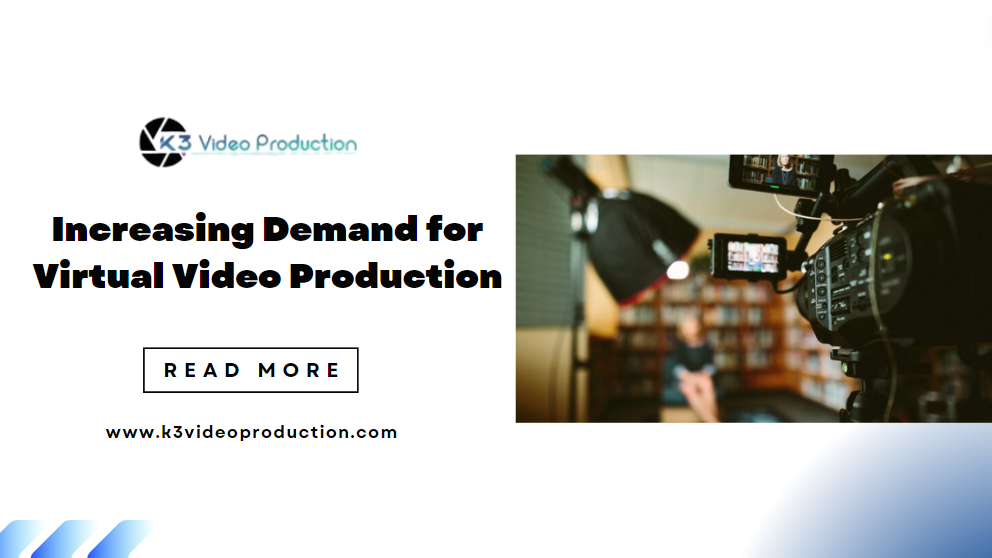Virtual video production has emerged as a game-changer in the digital era, fueled by technological advancements, changing consumer behaviors, and the need for engaging online content. This blog delves into the factors driving the soaring demand for virtual video production services.
Table of Contents
TogglePandemic Impact:
The pandemic hastened a move towards virtual experiences and digital consumption of content. Restrictions on in-person meetings and events made businesses, organizations, and individuals turn to virtual platforms for communication, entertainment, education, and marketing. Virtual video was key to immersive, interactive and impactful content creation in a Covid-19 era.
Global Accessibility:
Having virtual video production, businesses can reach the whole world without any difficulty. Virtual events, conferences, webinars, and meetings are widely acceptable as they enable businesses to interact with customers, partners, and other stakeholders regardless of geographical boundaries. With this increased coverage and reach more and more people want to use top-class virtual video production services.
Enhanced Engagement:
Digital videos provide an immersive and engaging environment that hooks people. Characteristics such as 3D animation, virtual sets, augmented reality (AR), and interactive tools enhance the viewer’s experience making the content more unforgettable, interactive, and worth sharing as well. Companies employ virtual video production to develop convincing stories, product presentations, training courses and virtual tours for the viewers which produce high engagement ratings.
Cost-Efficiency:
Usually, the virtual video production incurs less costs than the conventional video production methods. With lowering of overheads, travel costs, logistics associated with physical shoots, business will still be able to produce high-quality video content but within the budget constraints. This cost-effectiveness attracts organizations of all sizes from small startups to major multinationals, which contributes to an increased demand for virtual video production services.
Versatility and Flexibility:
Virtual video production includes all advantages of versatility and flexibility in content production. Virtual production which is capable of producing corporate videos, commercials, documentaries, live streams and even virtual reality (VR) experiences, offers ability to be creative, flexible and adaptable in meeting the diverse demands of the projects.
Tech Advancements:
The innovations in technology, including real-time rendering, motion capture, green screen technologies, and virtual production studios, are the ways that content creators can push the boundaries of virtual video production. These tools accommodate the blending of virtual components to the live footage action, which results in creating diverse and dynamic visual effects, realistic simulations, and captivating imagery that helps the storytelling.
Sustainability:
The virtual video production corresponds to sustainability initiatives through the reduction in emissions which come with the conventional production techniques. Due to less physical resources, energy consumption, and waste production, virtual production plays a key role in eco-friendly practices, thus it appeals to green customers and industry.
The rising demand for virtual video production is due to its provision of captivating, reachable, economical, versatile and sustainable content solutions. With businesses more and more adopting digital transformation and focusing on being present in the online marketplace, virtual video production becomes a crucial element in the future of content creation and consumer engagement.
How to Plan for Virtual Production Shoot
Virtual production is now central to today’s entertainment, delivering extremely realistic and dynamic experiences to audiences all over the world. The process of a successful virtual production shoot, when planned properly, requires paying attention to many aspects in order for a streamlined and effective outcome. undefined
Define Objectives and Goals:
First and foremost, put down the objectives and goals of your virtual production shoot clearly. Come up with a purpose for the video, identify the audience, the main messages, the results, and the metrics that will be used to assess the success. Identifying your goal will be your compass for the entire planning and execution process.
Storyboard and Script:
Create a storyboard and script that describes the visual elements, scenes, dialogues, and actions which will be part of virtual production. Collaborate with writers, directors and creative teams to come up with a good story that resonates well with your target audience and captures their attention.
Choose the Right Virtual Production Technology:
Pick the right virtual production technology based on the requirements of your project. These include virtual sets, green screen installation, motion capture, real-time render engines and virtual reality (VR) tools. Analyze various platforms, software, and equipment for their compatibility and performance efficiency.
Set Design and Virtual Environments:
Create virtual sets, backgrounds, and environments which match your story line and make the visuals interesting. For example, lighting, colors, textures, and 3D elements can be used to build virtual worlds that are immersive and realistic. Collaborate with designers, animators, and technology personnel to translate your vision into reality.
Casting and Talent:
Identify the right people, actors, presenters, or avatars for your virtual production. Organize auditions, rehearsals, and talent screening to create a cohesive and professional performance. Guide the actors in character development, emotions, and delivery to make them on screen presentable.
Technical Rehearsals and Testing:
Carry out the requisite technical rehearsals and tests before the actual shoot. Evaluate virtual set interactions, camera movements, audio synchronization, visual effects, and live streaming functionalities. Address any technical difficulties, bugs, and disparities to make the production process seamless.
Logistics and Production Crew:
Coordinate logistics, schedules, and resources for the virtual production shoot. Make the necessary arrangements for equipments rentals, props, costumes, makeup, and catering services. Recruit competent production staff of directors, cinematographers, sound engineers, editors, and technicians who would oversee the process and ensure quality work.
Post-Production and Editing:
Plan for post-production tasks such as editing, visual effects, sound mixing, and color grading. Work closely with editors, VFX artists, and post-production teams to refine and enhance the footage, add special effects, and polish the final output for distribution.
Promotion and Distribution:
Create a plan for the marketing and distribution of your virtual production content. Use digital marketing channels, social media portals, streaming platforms, and virtual events for reaching out to your target audience and increasing the level of engagement. Measure the success of virtual production shoot by monitoring audience feedback, analytics and performance measures.
Through such steps and the careful planning you can make a successful headshot photographer shoot which can render compelling, immersive and meaningful content to your audience. Accept the potential of virtual production technology to increase storytelling, creativity, and audience strength in the digital era.
Contact K3video Production for dedicated, thoughtful, and captivating animated sales videos.
Reach us on our social media platform Facebook








